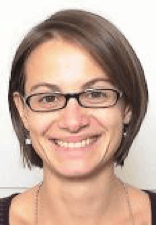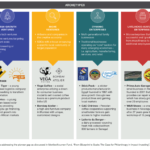Closing the Gap: Identifying Key Challenges for the Missing Middle SMEs in Francophone West Africa
Many small and medium-sized enterprises (SMEs) in developing countries face a classic conundrum when it comes to securing finance. Most constitute the “missing middle,” as they are considered too big for microfinance institutions (MFIs) and too small or risky for traditional finance providers such as commercial banks.
This dilemma is well known, but to truly solve it, we need to know more. To get a deeper understanding of the missing middle SME sector, (which for the purposes of this article we refer to as MM-SME), and how to support it, the Dutch Good Growth Fund (DGGF) commissioned several studies on the entrepreneurial ecosystems of six francophone West African countries – Benin, Ivory Coast, Guinea, Mali, Senegal and Togo. The reports were published as part of DGGF’s #ClosingTheGap series, with research for the country studies conducted by Enclude.
I recently interviewed Julia Kho, knowledge manager at TripleJump, an investment management and advisory services firm that, along with PricewaterhouseCoopers, manages DGGF’s Investment Funds Local SMEs effort.
Ekta Jhaveri: Why was the francophone West African region chosen by DGGF for #ClosingTheGap studies?

Julia Kho
Julia Kho: The DGGF supports financial intermediaries across the developing world, the mandate covers 68 countries in total. Local financial stakeholders reach out to DGGF for funding support. We received very few proposals from this region. That is why DGGF commissioned these studies to get a better understanding of the SME landscape and the ecosystem around them. The intent was to identify, elaborate on and strengthen existing and potential solutions – including fostering the appetite of investors in investing in local SMEs in the region – to address key challenges and obstacles faced by the missing middle entrepreneurs. Now we see more fund managers addressing this market and expect more activity in the coming years.
EJ: Can you briefly describe the process of entrepreneurial ecosystem assessments?
JK: The entrepreneurial ecosystem assessments were conducted using the ecosystem toolkit created by the Aspen Network of Development Entrepreneurs (ANDE). It involves analyzing the ecosystem along six dimensions or domains – culture, policy, markets, finance, support and human capital. A literature review was followed by field visits to conduct interviews with the stakeholders from the various domains. The fieldwork was followed by a workshop of key stakeholders to discuss findings and possible solutions to close the identified gaps along the six domains.
EJ: How do you characterize or define the missing middle SMEs in francophone West Africa? Were these SMEs homogenous across the six countries?
JK: The starting point of our definition of the MM-SMEs was the one mentioned above. We found that it was important to sub-segment the MM-SME sector in order to get a deeper understanding of the characteristics of local enterprises and their needs and regroup them under clusters that share these common characteristics and needs. The sub-categories we came up with are fairly general and they can be applied across countries; where they differ is around the relative representation of the sub-category by country. So, even though the markets in each of the six francophone West African countries differ, at a high level this sub-segmentation of the SME sector applies. The sub-segments we defined and found were a very large cluster of small necessity entrepreneurs (established for the sake of providing livelihood) followed by moderate growth entrepreneurs (mainly family-owned businesses), and smaller clusters of high-growth startups (young entrepreneurs mainly in the technology sector), opportunity-driven SMEs (entrepreneurs copying successful business models and involved in several businesses) and gazelles (successful startups with high growth rates).
While this sub-segmentation of the SME sector is an important exercise, we are now embarking on a deeper study with the Omidyar Network and DGGF. Its goal is to create a robust segmentation framework of SMEs, which will help investors and intermediaries match appropriate financial products with different enterprise segments, as well as help entrepreneurs understand the most appropriate investors to target.
EJ: Were the challenges more systemic or operational? Can you elaborate on the top three challenges across the six countries?
JK: Both – systemic and operational. While there is some variation across these countries, the few general challenges we saw were:
- Weak entrepreneurial culture: Entrepreneurship is generally not promoted or celebrated as it is not perceived to be the venue one takes to be successful. Culturally, one is considered successful if they work in the government or as an employee of a big company. In francophone West Africa, the government is very involved in supporting the development of the private sector. There are many public entities that look after issues of SME development. Despite good intentions, civil servants haven’t been able to achieve the anticipated impact, as they often are unable to relate to the realities of running a business.
- Policy Framework: The informal sector in these countries is very large. Between 70-90 percent of the SMEs are considered informal businesses and going formal is perceived by local entrepreneurs as too costly (time and money) and complex (the process). Many don’t see the value in going formal. This is a real issue as informal businesses can’t access formal financial services.
- Finance: The challenge is on two levels. Firstly, SMEs don’t have an accurate understanding of whether they need external financing and what their specific financing needs are. Secondly, the financial landscape is largely comprised of banks and MFIs that provide collateralized debt. SMEs without a track record, collateral or positive cash flow are hence limited in accessing the available financing options. The six countries demonstrate different levels of maturity. We’ve seen that in Senegal and Ivory Coast, for instance, a few players are recently emerging to provide mezzanine finance and equity.
EJ: Were there any surprising findings from the entrepreneurial assessments you conducted with SME owners? Can you elaborate on a couple of these findings?
JK: I don’t know if these are specific to the region but we found a couple of things that were very interesting if not surprising. First, there is no shortage of dynamic entrepreneurs. The challenge lies in how they look at their business and in understanding their own needs. Entrepreneurs tend to talk about the need for external finance to grow their business. But often when discussing their business further, it appears that the first need is to secure recurring customers to sustain regular revenues and then think about finance, i.e. what type of financial support they need for which purposes. In the region, given the current financial service offerings, we identified that stakeholders are aware of debt products but their exposure to other financial instruments and products is extremely limited and hence their understanding of those, too.
Another finding is related to the varied level of professionalism and sophistication of local businesses. Keeping records of levels of production and supply needs, for instance, and analyzing those to identify what is needed not just to operate tomorrow, next week or next month but rather the next year, is not necessarily a common practice.
EJ: What are the different types of stakeholders (financial and non-financial) that provide support to SMEs? What is the level of collaboration among them?
JK: In addition to what was said earlier on the current financial offers, we identified a gap in financing at the very early stages of development of local enterprises. There are barely any players that can offer external funding (that is not collateralized debt) in the range of 10,000-1 million euros.
On the non-financial side of things, again, in addition to what was said earlier, we see a positive trend of one-stop shops being set up to provide information for local businesses such as how to register, etc. However, besides the few traditional business support development service providers that can be expensive, full-fledged service providers that help entrepreneurs – from the conceptual to commercialization stage – at affordable prices are extremely limited.
As a direct response to this identified gap, DGGF is supporting Suguba, a network of impact hubs that originated in Mali and which are looking to expand to Senegal and Ivory Coast. We are also supporting EtriLabs, a tech innovation hub in Benin and Innov’Up, a women-focused incubator in Togo.
As in many ecosystems, we observe that local stakeholders tend to be disconnected. If the SME sector is not sub-segmented based on characteristics and needs of local enterprises, then the service offering is not targeted and specialized, which makes collaboration challenging. Our work with Omidyar Network (mentioned above) is important as it will provide an understanding of the appropriate financial products based on different enterprise segments.
EJ: A pilot study for the #ClosingTheGap series was done for Kenya in 2015. Are there any learnings from the Kenyan entrepreneurial ecosystem assessment that can be applied to these six countries?
JK: There is no one-size-fits-all approach. There are many variations across the countries and Kenya has an ecosystem that tends to be more dynamic than the six countries we’re discussing. What we learnt was that the sub-segmentation methodology piloted in Kenya was applicable to any other market and that the sub-segments defined through the Kenyan study were also relevant to the francophone West African markets, although the relative proportions of SME sub-segments representation are different. The entrepreneurial culture is promoted in Kenya. There is diversity in terms of ecosystem players: MFIs, banks, mezzanine/venture capital/private equity funds, hubs, incubators and accelerators – and they intervene at different stages of maturity of the enterprises. We saw some linkages with universities (e.g. a hub or incubator hosted by a university). In fact entrepreneurship education is part of some high school/university curricula, which we don’t see in francophone West Africa.
EJ: What other types of innovative financial instruments have the potential to increase access to finance for such SMEs – and which types of financial institutions are best positioned to fill this need?
JK: There are steady moderate growth companies, often family-owned, whose service or product offerings address a market demand but they may still lack the track record, collateral, cash flow or profit levels that can qualify them for a bank loan. These companies require more risky (less collateralized), flexible and long-term capital to grow. This is what we refer to as “mezzanine finance,” which blends elements from traditional private equity and debt financing into a unique product. DGGF commissioned a study in 2016 that dives into this interesting additional offering for missing middle entrepreneurs and seems relevant to local enterprises in the region.
EJ: There is a lot of talk in the development community about the use of blended finance for the missing middle SMEs. What are your thoughts on this?
JK: The concept of blended finance is an interesting one. We see it as particularly relevant to foster innovations, i.e. to test and launch new and different financial products and models. In my mind, local intermediaries – both financial and non-financial ones – would benefit from this type of financial support to try out and identify what works/does not.
All the reports under the #ClosingTheGap series can be accessed on the DGGF website.
Top image: Employees from different ethnic groups are seen at work at a carpentry in Gao, Mali. Flickr credit.
Ekta Jhaveri is senior research associate for the Healthcare and Financial Sector Development Initiatives at the William Davidson Institute, NextBillion’s parent organization.
- Categories
- Investing




